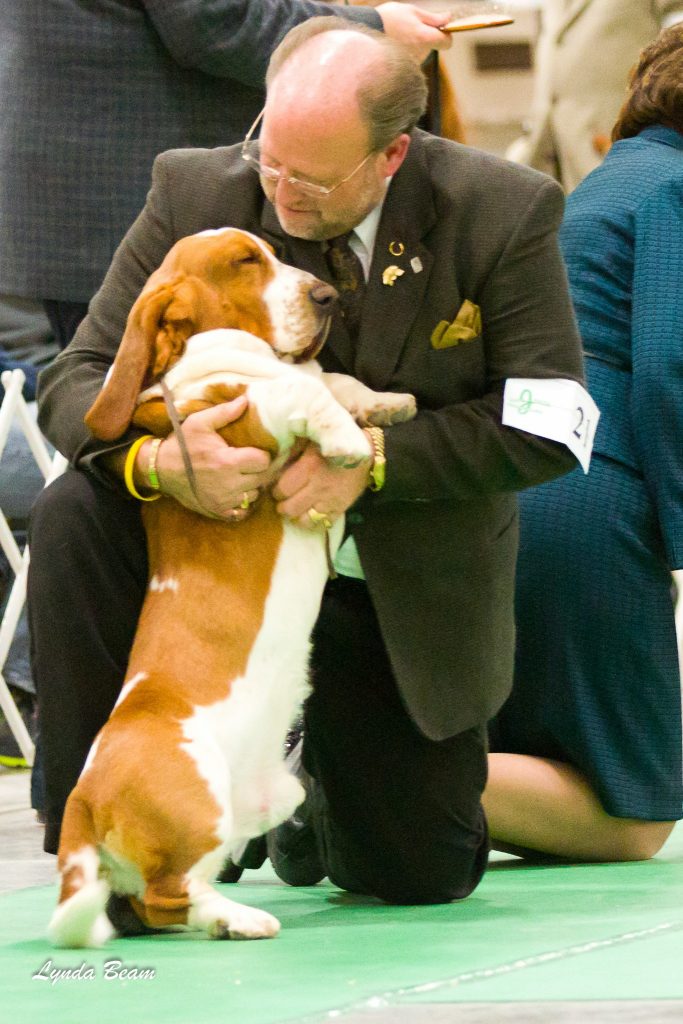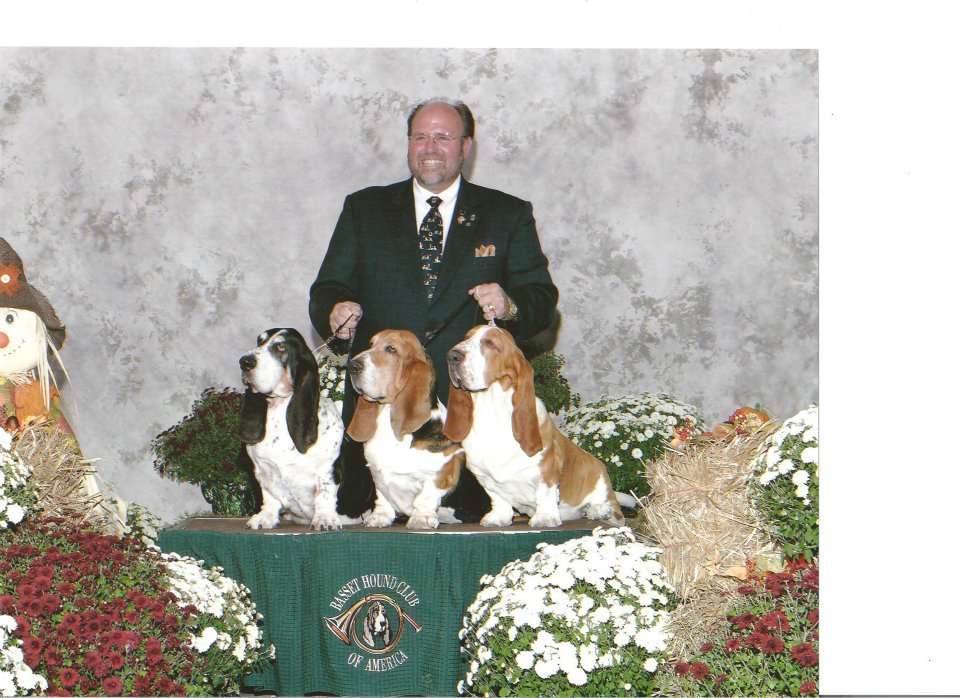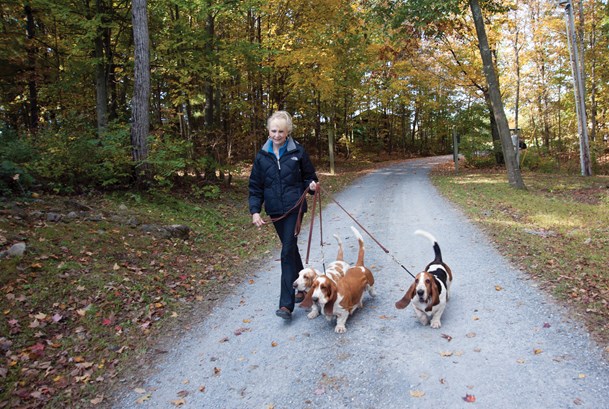478 — Bryan Martin: Read Your Standard and Dream BIS Line up
Bryan Martin: Read Your Standard and Dream BIS Line up
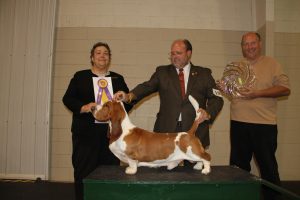 Bryan Martin, retired professional handler, former AKC executive field representative and newly minted Hound group judge joins host Laura Reeves for part two of his amazing stories and advice for exhibitors.
Bryan Martin, retired professional handler, former AKC executive field representative and newly minted Hound group judge joins host Laura Reeves for part two of his amazing stories and advice for exhibitors.
“My family would have dinner (and) during dessert, the book of standards came on the table. We had weekly discussions. ‘OK let’s talk about heads tonight.’ We’d go round the table and everyone would say something and ‘OK who do you think has a good head? Who do you think has a bad head? Do you have a picture? Go get a picture.’ One night we’d talk about shoulders and why the shoulder needs to be a wrap-around, why the shoulder needs to be well laid back, why the shoulder blade and the upper arm have to be the same length, to make it a proper working hound, how the back end has to match the front end… How the pieces fit. It’s form and function, which has stuck with me forever, and that’s my basis is form and function judging.
“It’s amazing how many people in AKC, UKC … have no understanding how to read a standard. How to interpret a standard and how to go to somebody and talk to somebody about the standard. The how’s why’s and wherefores of studying standards. At the International show where we had to write a critique, we had to know the standards. What I ended up doing was showing people what the standard says about their dog. And they say ‘oh, I didn’t know that’ and it’s a whole educational program that is missed.”
In the “Dream Best In Show Lineup” game, Martin’s choices were:
Sporting – English Springer Spaniel, Ch Salilyn’s Aristocrat
Hound – Afghan Hound, Ch Triumph Of Grandeur
Working – Doberman Pinscher, Ch. Brunswig’s Cryptonite
Terrier – Scottish Terrier, Ch. Braeburn’s Close Encounter
Toy – Japanese Chin, GCh. Pem We-Syng Lucky MI
Non-Sporting – Dalmatian, Ch. Spotlight’s Spectacular
Herding – German Shepherd Dog, GCh. Altana’s Mystique
Finally, Best in Show in this mythical lineup??
Shannon, the Scottish Terrier, shown by George Ward.
Listen above to hear all of this and more.
477 — Bryan Martin: “Basset Boy,” the Early Years
Bryan Martin: “Basset Boy,” the Early Years
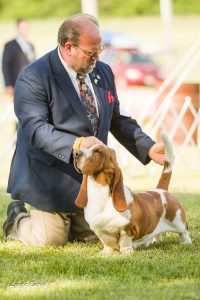 Bryan Martin, retired professional handler, former AKC executive field representative and new judge of the hound group joins host Laura Reeves for part one of a wide ranging, fascinating conversation.
Bryan Martin, retired professional handler, former AKC executive field representative and new judge of the hound group joins host Laura Reeves for part one of a wide ranging, fascinating conversation.
World famous for his work with Basset Hounds, Martin shares his early history growing up in the sport with his family and early mentors.
“I was six years old in 1960 when we went to a fun match for the Fort Dearborn Basset Hound club,” Martin said. His mother had saved up her grocery money to purchase a Basset Hound bitch who was bred to a local stud dog. They brought the puppies to the match and didn’t win anything. A club member after watching the family, approached his father with an offer he couldn’t resist.
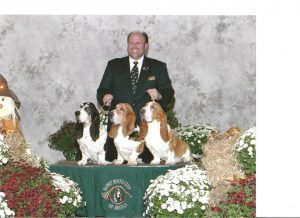
“My Three Sons” taken at the 2006 BHCA Nationals. The ONLY time the top three, all-time Best in Show winning Basset Hounds competed at the same show! L-R Ch Deerhill’s Great Gatsby, 52 all-breed bests, Ch Topsfield Bumper Cars, 45 all-breed bests and Ch Topsfield Beethoven, 34 all-breed bests, 131 in total! — Bryan Martin
“She said, ‘You know, your puppies, they’re not good. If you like to do this, I suggest you just sell the whole lot and come out to my kennel and I’ll take care of you.’ So, we did. We went out to this kennel and she said, ‘I think this is a good bitch for you. This will be a good foundation bitch for you and I’ll give you a buddy for her and the kids can work on that one.’
“We bred a litter about every year and so I got to show all the class dogs. My brother, Peter, was the Prince and he always got the specials dogs. He didn’t mess with the class dogs. But that was to my advantage, because I got to learn that you never show two dogs the same way. Like people, they all have a different personality and they all respond differently to what you do and so you work on adjustments.
“The living room (in our house) was big enough that we could move all the furniture to the side and put the couch in the middle and we had a dog show ring. We would practice dog shows. My father would either sit in the corner or on the couch in the middle. We put a mirror on the floor against the couch and we’d learn to set up our dogs in front of the mirror, to see what the judge was seeing. So if you had to poke him in the top line or to hold the tail different or whatever you could see it and that was my learning on how to show the breed.”
From secretary for horse shows just out of college to marrying Nancy, through showing record-breaking dogs for Claudia Orlandi, Martin’s journey through the sport of dogs and his nuggets of knowledge are priceless.
Listen to part one here and join us next week for part two.
168 – Breeder Education Advocate Claudia Orlandi Shares Knowledge
CLAUDIA ORLANDI ON EDUCATION AND DOG BREEDING
AN EARLY “EYE FOR A DOG”
Orlandi grew up with miniature and standard Poodles, but her first show dog was a Saint Bernard from Betty Roberts. When her family visited the breeder to pick a puppy, somehow the divider between the “show” dogs and the “pet” dogs had fallen down. With an “eye for a dog” at even an early age, the puppy her family chose led Orlandi into a life of dog shows. Eventually, shown by Bob Forsyth, that Saint Bernard became a Best in Show Winner.
“…structure and performance or, form following function, are the key characteristics of breed type and are what distinguish one breed from another.”
Horses and dogs were a passion she shared with her first husband, Dom. They acquired their first Basset Hound from a pack in Vermont. There they learned the functional aspect of their hound by following the pack on rabbit hunts. Orlandi now lives part-time in Spain, where she had just returned from a month of hunting with her hounds when we spoke for this interview.
“… I have to say that having had the experience of hunting with Emma (her first Basset) was a great starting point for really understanding the basset hound breed,” Orlandi said. “…structure and performance or, form following function, are the key characteristics of breed type and are what distinguish one breed from another.”
Orlandi attributes much of her knowledge of anatomy and animal husbandry to the 4-H program. In her shout out to the horse 4-H program she noted, “We had to pass difficult written and hands on tests on equine anatomy and movement, in addition to giving presentations and learning animal husbandry. All of this knowledge relating to horses, I was easily able to apply to breeding and showing dogs.”
But as she progressed in her breeding program, she came to understand that other breeders didn’t have the same good fortune.
“If we to learn about photography we can go to photography school,” Orlandi said. “If you want to become better cooks, we can take cooking classes. But at that time, we really didn’t have anything comparable if we wanted to learn to become better breeders.”
Knowledge is power, Orlandi noted, in everything that we do. So, she began to develop her education programs and books, including the fabulous Basset Hound University program she created and has shared with other Parent Clubs. She insists that breeders can be successful with some basic information to help them move forward.
Some of her best recommendations?
- …the concept of preservation breeding is an extremely important topic that deserves our ongoing support and attention.
- …one of the biggest myths is the belief that because breeding revolves around chance and randomness applying genetic principles won’t make a difference. Nothing could be farther from the truth. In reality, it’s very unlikely that a breeder can consistently produce healthy, quality dogs in which every generation the dogs are better than they were in the previous generations, without understanding how traits are passed from one generation to the next.
- …don’t purchase a bitch younger than 12 to 18 months. If you get a bitch much younger than this, they have not been able to do enough health tests and body structure might still be developing.
- …I think it’s really difficult, in a way, to find a good person to work with in a breeding program or to find a mentor. Because in a way it’s kind of like a marriage. I think you have to be psychologically compatible and you have to have a lot of the same goals and the same beliefs in common.
- … a few decades ago if people were honest about health problems they are absolutely shunned, many times, by their peers. Talking about health was considered taboo. Nowadays, we understand much more about controlling canine genetic disease and we know that if we’re honest about the health problems, about who the affected dogs are in our pedigrees we can control health problems in our breeding program very, very easily. But it all revolves around being honest.
Please enjoy my visit with this legendary advocate for breeder education in purebred dogs.

